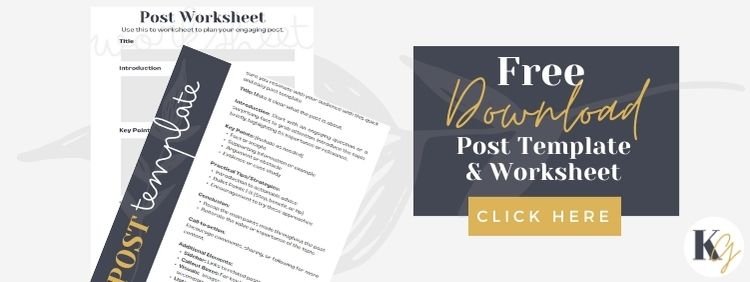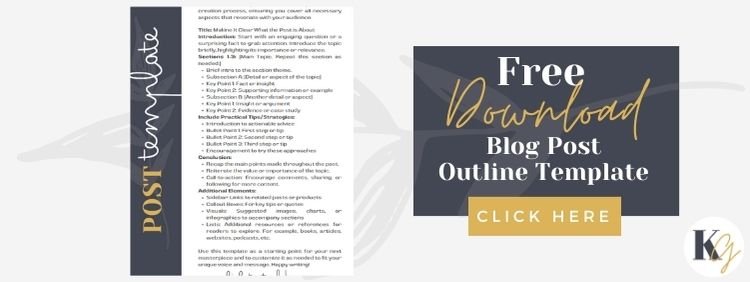
For online business owners and startups, the art of creating remarkable blog content is not just a luxury but a critical component of their online presence and success. But making your blog posts truly amazing involves more than just stringing words together — you need a strategic, empathetic, and informed approach. Here’s everything you need to know to craft blog content that resonates deeply with your readers and truly helps solve an unmet need.
Understanding Your Audience
Before you even hit the keys, it’s imperative to have a solid grasp of who you’re writing for. Your audience dictates your tone, the level of technicality, and the relevance of your content. For startups and online business owners, this often means understanding your target customer’s demographics, interests, and pain points.
Use our worksheet to help you personalize your content and address your audience’s problems, aspirations, and interests.

[purchase_link id=”11122″ style=”button” color=”blue” text=”Free Download”]
Market research, surveys, and social media listening are goldmines for discovering what makes your audience tick. Use these insights to build audience personas; fictional, generalized representations of your ideal customers or readers, then write to engage them directly. Personalize your content and address your audience’s problems, aspirations, and interests.
Keyword Research
All great content starts with a great topic. Your aim should be to write about something that not only appeals to your audience but also stands a good chance of ranking in search engine results pages (SERPs) — this is where keyword research comes into play. Tools like Google Keyword Planner or SEMrush can help you identify high-potential keywords related to your industry or niche.
Grab our Keyword Worksheet and use it to track your research, organize your findings, and refine your keyword list. Once you have a solid list of keywords, you can start brainstorming content ideas that will resonate with your audience and align with those keywords.

[purchase_link id=”11132″ style=”button” color=”blue” text=”Free Download”]
Once you’ve found your keywords, it’s time to validate your ideas. Scour the internet and social media platforms to see what kind of content already exists for your topics. Where are the gaps? Can you provide a new perspective, valuable data, or updated information? Plan your posts ahead of time, creating an editorial calendar to organize your publishing schedule.
Engaging from the Outset
Your audience’s attention is a precious yet fleeting commodity. The first few sentences of your blog post should serve as a hook that grabs them and pulls them in. An engaging hook can be a compelling question, a bold assertion, an anecdote, or a relevant statistic. Remember, the aim is to ignite curiosity and keep your readers wondering what comes next. The headline is equally crucial; it should be clear, concise, and promise value.
- Did you know that over 50% of start-ups fail within the first four years? Discover the key strategies for ensuring your business thrives.
- Imagine cutting your daily work hours in half while doubling your productivity. It’s not only possible; it’s easier than you think.
- In a world where every second counts, could mastering time management be the ultimate superpower?
- This one mistake could be costing your business thousands of dollars a year. Find out what it is and how to fix it.
- What if I told you that you’re only five steps away from achieving your dream career?
- Last year, a revolutionary idea changed the tech industry forever. Here’s how it happened.
- 75% of people believe they’re not living to their fullest potential. Are you one of them?
- They said it was impossible. They were wrong. Here’s the story of how one small change can lead to monumental results.
- Why do some people seem to have all the luck? The answer might surprise you.
- Forget everything you thought you knew about healthy eating. This new research turns it all on its head.
After securing the audience’s attention with an irresistible hook and headline, the introduction must then set the stage for what’s to come. It’s here that you provide a clear roadmap of the post, briefly outlining the key points or arguments you will discuss.
This not only maintains the reader’s interest but also establishes trust by showing you have a deep understanding of the topic. An effective introduction promises readers that their time will be well spent, offering them insightful solutions, fascinating revelations, or new ways of thinking about familiar subjects.
Structuring Your Content: A Path to Clarity
Once you’ve got their attention, it’s important to keep your readers engaged through a logical and clear structure. A blog post typically consists of an introduction, the main body (broken down into subheadings for clarity), and a conclusion. Each section serves a specific purpose and helps guide the reader through your argument, narrative, or insights.
Our blog post template can help you stay organized and on track crafting great blog posts. Download it for free here:

[purchase_link id=”11140″ style=”button” color=”blue” text=”Free Download”]
Subheadings also benefit the scannability of your post, a factor that’s particularly important in the digital age, where readers often skim first before deciding to commit to the full read. Furthermore, consider using bullet points or numbered lists when listing items, as these break up text and make information more digestible.
Writing for Readability: Keep It Simple, Keep It Scannable
In an era of information overload, simplicity is not just preferable — it’s essential. Write in a clear, direct style, devoid of jargon or superfluous text. If your audience needs to work hard to understand your content, they won’t.
- Focus on Clarity: Start with a clear idea of what you want to convey and structure your sentences to reflect that idea without ambiguity.
- Use Short Sentences: Break down complex ideas into manageable, shorter sentences to enhance comprehension and retain reader interest.
- Utilize Bullet Points and Lists: When possible, use bullet points or numbered lists to organize information, making it easier for readers to scan and digest content.
- Limit Jargon: Keep technical terms and industry jargon to a minimum. When they are necessary, provide a short, understandable definition.
- Active Voice Over Passive Voice: Use active voice to make your writing more engaging and direct. For example, “The team achieved the goals” instead of “The goals were achieved by the team.”
- Choose Simple Words: Opt for simple, straightforward words over complex vocabulary. This ensures that your content is accessible to a wider audience.
- Edit Ruthlessly: After writing, review your work with a critical eye. Remove redundant phrases, unnecessary modifiers, and anything else that doesn’t add value to your message.
Short sentences and paragraphs contribute to readability, as do transitions that link ideas coherently. Use active voice to keep your writing dynamic. Remember, more readable content translates to a better user experience, a quality that search engines reward with higher rankings.
Writing for readability is critical in reaching and engaging your audience effectively. By focusing on clarity, using short sentences, employing bullet points for organization, limiting jargon, preferring the active voice, choosing simple words, and editing rigorously, you can ensure your content is accessible and enjoyable for all readers.
These strategies not only improve the user experience but also enhance your content’s visibility and impact. Remember, the essence of good writing lies in its ability to communicate ideas clearly and concisely.
Adding Value: The Essence of Great Blog Posts
Your reader’s time is valuable, so every blog post should offer something of significance. This can be in the form of insights, advice, solutions to problems, or entertainment. Value can also come from depth — don’t shy away from thoroughly exploring a topic or confronting it from various angles. In doing so, your blog gains authority and your reader gains trust in your expertise.
- Provide Actionable Tips: Readers appreciate when they can apply the knowledge right away. Include steps, tips, or how-to guides that empower them to act on what they’ve learned.
- Incorporate Real-Life Examples: Stories and case studies make abstract concepts relatable and demonstrate how theories apply in the real world.
- Invite Guest Contributors: Collaborating with experts or influencers can introduce fresh perspectives and deepen the content’s authority.
- Use Multimedia: Add images, videos, or infographics to complement and enhance the textual content, making it more engaging and easier to digest.
- Encourage Interaction: End posts with a question or call to action that invites comments or shares, fostering a community around your blog.
- Offer Exclusive Content: Provide access to additional resources, such as ebooks, whitepapers, or webinars, to readers who sign up or engage with your blog.
- Stay Current: Update your blog posts with the latest information, trends, and developments in your field to ensure content remains relevant and valuable.
Incorporate examples, case studies, and practical applications where appropriate. They not only illustrate your points but also make your content relatable. Always back up your claims with sources, data, or experiences. This adds credibility and again, builds trust.
Adding value through your blog posts is not just about the information you provide but about the experience you create for your readers. Whether it’s by breaking down complex topics, offering actionable insights, or inviting them to be part of a community, the essence of great blogging lies in enriching your audience’s knowledge and positively impacting their lives.
Optimizing for SEO: Making Sure Your Voice Is Heard
Search engine optimization (SEO) is the process of optimizing your web content to rank higher in search engine results. While the user should come first, SEO shouldn’t be an afterthought. Sprinkle your targeted keywords throughout the post naturally, and incorporate them into your title, meta description, and URL structure.
- Research Keywords: Before writing your post, use a tool like Google Keyword Planner to find relevant keywords with high search volume and low competition. If you want to learn more about using Google Keyword Planner, this article will help. Keywords will be the building blocks of your content.
- Use Long-Tail Keywords: Incorporate long-tail keywords into your content. They’re less competitive and more specific to your audience’s search intent, making it easier for your target readers to find you.
- Optimize Your Headings: Structure your content using H1 for the title and H2s for main headings. Include your primary keyword in the H1 and spread secondary keywords throughout the H2s for better search engine visibility.
- Create Quality Content: Write comprehensive, in-depth content that addresses your audience’s questions and needs. Quality content is more likely to earn backlinks, a key component in ranking higher in search engine results.
- Optimize for Mobile: With over half of all web traffic coming from mobile devices, ensure your website is mobile-friendly. Google’s mobile-first indexing means your site’s mobile version will impact your search engine rankings.
- Improve Page Load Speed: A slow-loading site can hurt your bounce rate and rankings. Use tools like Google PageSpeed Insights to analyze and improve your blog’s loading time.
- Use Internal Links: Link to other relevant posts and pages within your blog to keep readers engaged, reduce bounce rate, and help search engines crawl your site more effectively.
- Update Old Content: Regularly revisit and update your older posts with fresh information, links, and keywords to keep them relevant and ranking high in search engine results.
Optimizing your blog for SEO is a powerful strategy to ensure your voice reaches the masses. By incorporating these techniques, you’re setting the stage for increased visibility and engagement. Remember, the goal is to not only attract visitors to your site but also to provide them with value that keeps them coming back. Keep refining, keep updating, and most importantly, keep creating content that resonates with your audience. Your dedication will pay dividends in the form of a loyal reader base and a prominent position in search engine results.
The Call to Action: Guiding Your Readers
The end of your post is a not-so-subtle nudge to encourage your reader to take further action. Decide on the purpose of each blog post; whether it’s signing up for a newsletter, downloading a free resource, or purchasing a product, and include a call to action (CTA) that reinforces that purpose.
- Subscribe Now for weekly insights straight to your inbox.
- Download Your Free Guide to mastering SEO basics.
- Join Our Community to connect with experts and enthusiasts alike.
- Start Your Free Trial and experience premium features today.
- Book a Consultation to take your strategy to the next level.
- Get Your Discount Code by signing up now.
- See Plans and Pricing for detailed information on our offerings.
CTAs should be clear and compelling, using actionable language and, ideally, they should benefit the reader in some way. Whether it’s ‘Discover more’, ‘Start Now’, or ‘Download your checklist,’ CTAs guide your reader to the next step in their engagement with your brand.
Conclusion: Writing to Success
Creating amazing blog content requires a balance of art and science. It’s about knowing your audience, offering value, and being strategic in your approach. The process is iterative — as you write and analyze the reception of your work, you’ll learn more about what resonates with your readers and what converts them into customers.
By understanding these fundamental principles and consistently implementing them, you can transform a passive audience into an engaged community that views your blog as an unmissable resource. Happy writing, and may your blog content be as amazing as the value you offer!
For more essential tools, tips, and templates, visit our Business Hub. We’ll help you launch and grow an online business you love.



